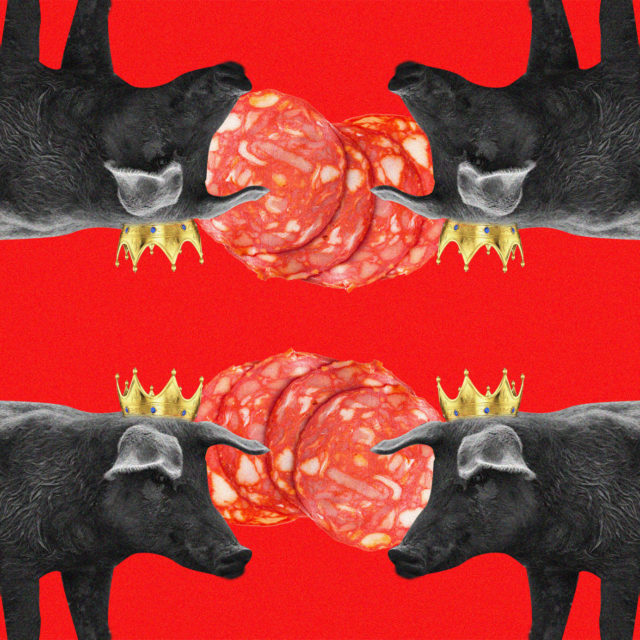The cured meats conversation all too often centers around the French and Italian traditions. Prosciutto and saucisson sec are both excellent, of course, but Jamón Iberico and chorizo also deserve a place at the (literal and figurative) table.
In Spain, the Iberian black-footed “pata negra” pig is king. Some of the best Spanish cured meat is from the acorn-grazed pata negra, which has been the case for centuries. In fact, in the third century, Liber Iudiciorum, or the Visigothic laws, set regulations around “hogs pastured on acorns.”
Styles and seasonings for “charcutería” vary by region, but here are five Spanish cured meats you should know — and what to drink with them.
Sobrassada
Sobrassada (sometimes spelled sobrasada) is a spreadable cured pork sausage from the Balearic Islands, flavored with paprika. While you can find spicy versions, it is mostly “dolç” or made with sweet paprika. It is usually made with the porc negre, an island relative of the pata negra. Traditionally, sobrassada would have just been made in the fall when the pigs were slaughtered, and there is still an October “Feria de la Sobrasada” or Sobrassada Fair in Campos, Majorca.
Pairing-wise, think of sobrassada as Spanish ‘nduja. It’s often served with honey, and would be lovely with a glass of cream sherry — the sweetness and chocolatey flavors of the wine bring out the layers of umami in this cured sausage. It is also deliciously (and traditionally) served with a cold lager like Estrella Damm. The freshness of the beer helps keep the saltiness of the sobrassada in check.
Jamón Iberico
There’s nothing like a good Spanish jamón, or cured ham. Unlike Jamón Serrano, which can be made with any breed of pig, Jamón Iberico must be made from pata negra. If you find Jamón Iberico de Bellota, that is the even more prized version where the pata negra pigs roamed freely while glutting themselves on “bellotas,” or acorns. Expect to pay $100 per pound or more when purchasing it in the United States.
The sweet, nutty notes of the Jamón Iberico pair beautifully with a salty manzanilla sherry or a fruity, layered Rioja crianza. The manzanilla sherry brings out the rich nutty character, whereas the Rioja crianza elevates the umami character. Either is spectacular.
Lomo
Lomo, not to be confused with the Peruvian dish lomo saltado, refers to a cured pork loin (lomo translates to “loin”), seasoned with salt, paprika, and garlic, then cured. While jamón tends to be more popular with tourists, lomo is just as beloved by the Spanish. You can also find Lomo Iberico and Lomo Iberico de Bellota.
Thanks to its shorter curing time (90 days as opposed to the two to three years that most jamón undergoes), lomo has purer porky flavors and is lovely with a fino sherry — the delicate, almondy notes of the fino bring out the meatiness of the lomo.
Chorizo
Chorizo is a dry-cured Spanish pork sausage, seasoned with salt, garlic, and paprika. Based on the type of paprika used, it is often labeled either picante (spicy) or dulce (sweet). There are also regional varieties, such as Chorizo Riojano, recognized by its horseshoe shape, and Chorizo de Pamplona, which is extra smoky and often includes pork. Chorizo de Bilbao, despite the name, is a Filipino sausage.
If you’re a fan of sour beer and tart flavors, pair chorizo with an Asturian cider for extra piquancy — its spicy, vibrant flavors do well with the funk of the cider. That pairing is especially wonderful when you add in a cheese called Torta del Casar, a sour, barnyardy sheep’s milk cheese from Extremadura. The rustic notes of the chorizo are highlighted by the tartness of the cider and cheese and the creaminess of the cheese.
Cecina
For those who don’t eat pork but want to experience Spain’s iconic cured-meat tradition, meet cecina. While cecina (coming from the Latin siccus meaning “dry”) could also be made with horse or rabbit, it’s most traditionally beef that’s been salted, dried, and sometimes smoked. The best-known regional version is Cecina de León, coming from Castile and León in northwestern Spain, which must be made with meat from the cow’s topside, silverside, flank, or rump, and with breeds indigenous to the region. It is salted, oak-smoked, and air-dried.
An aged Tempranillo will bring out the rich beefy notes in cecina. Or, try orujo, a pomace brandy common to León. Its fruity brashness will enhance the smokiness of the cecina.
